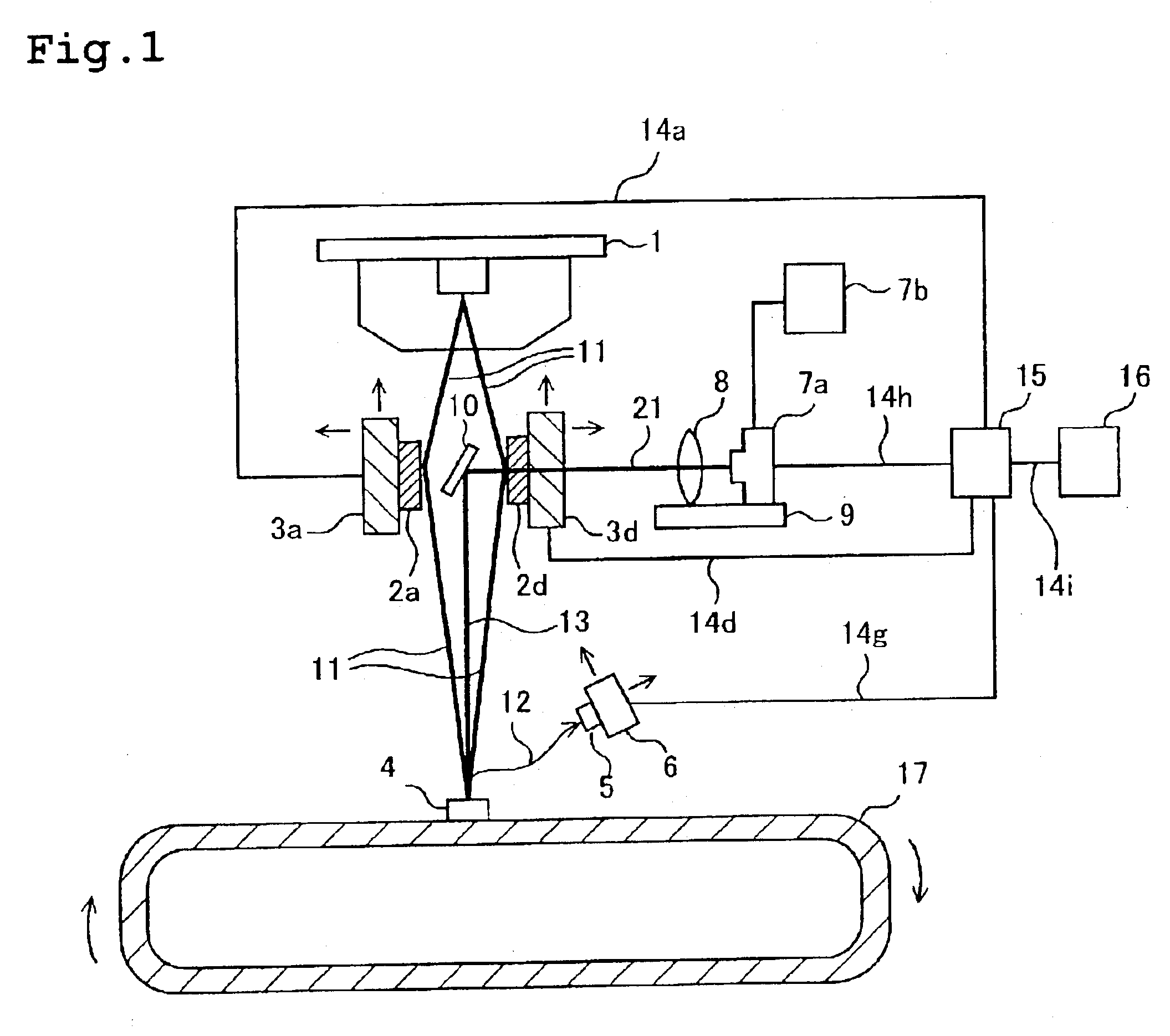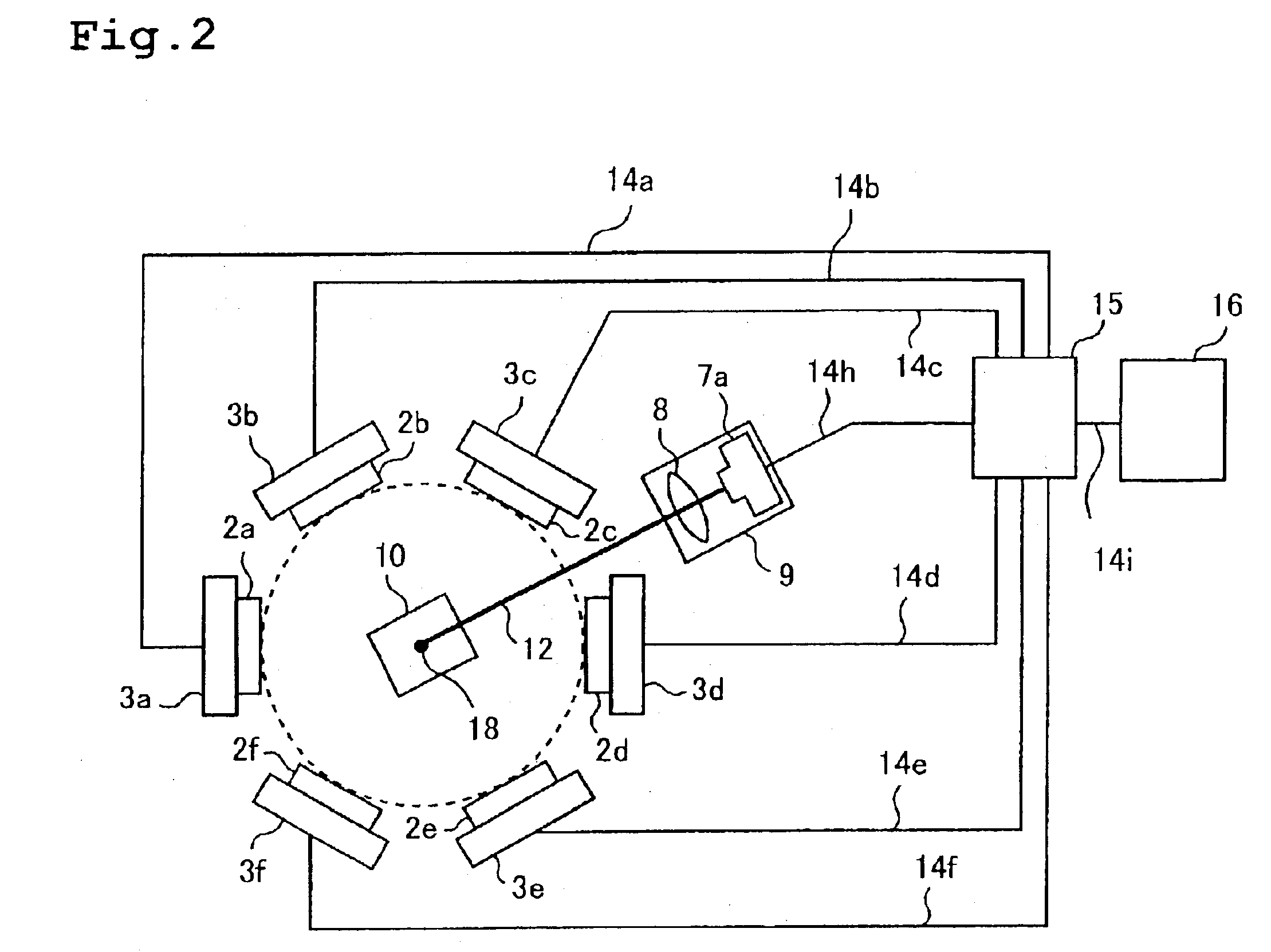Fluorescent X-ray analysis apparatus
- Summary
- Abstract
- Description
- Claims
- Application Information
AI Technical Summary
Benefits of technology
Problems solved by technology
Method used
Image
Examples
embodiment 1
[0013]FIG. 1 is an explanatory view showing a cross-sectional structure of a fluorescent X-ray analysis apparatus according to this invention. FIG. 2 is an explanatory view showing a structure of the fluorescent X-ray analysis apparatus of FIG. 1 as viewed from its top. The operation of the apparatus will now be described with reference to the drawings.
[0014]A primary X-ray 11 radiated from an X-ray tube (X-ray generation source) 1 is spectrally divided by spectroscopic elements 2a to 2f and the primary X-ray 11 is monochromatized. (In FIG. 1, only 2a and 2b are shown.) Monochromatization of the primary X-ray 11 is for the purpose of improving the analytic sensitivity of the fluorescent X-ray analysis apparatus. Specifically, the primary X-ray 11 radiated from the X-ray tube 1 usually has a certain width of wavelengths. However, if the primary X-ray 11 has a width of wavelengths, it becomes a noise source in generation and detection of a secondary X-ray, which will be described late...
embodiment 2
[0033]FIG. 3 is an explanatory view showing a cross-sectional structure of a fluorescent X-ray analysis apparatus according to this invention. In this embodiment, instead of the detection device for the surface position of a sample using the CCD camera in the apparatus described in Embodiment 1, a laser beam irradiating unit 19 and a laser beam detecting unit 20 are provided to measure the distance between an X-ray tube 1 and the surface of a sample 4 using a laser beam 22, thereby detecting the surface position of the sample and adjusting the positions of spectroscopic elements 2a to 2f. The laser beam irradiating unit 19, and the laser beam detecting unit 20 are connected with a control unit 15 by connection lines 14h and 14h′ and the measured distance between the X-ray tube 1 and the surface of the sample 4 is communicated to the control unit 15. With this structure, though the sample surface cannot be visually monitored, a commercially available laser-based length measuring mach...
embodiment 3
[0037]FIGS. 4A to 4C are explanatory views showing a structure of a fluorescent X-ray analysis apparatus according to this invention. In this embodiment, curved spectroscopic elements are used instead of the parallel plate-like spectroscopic elements of the apparatus described in Embodiment 1. Specifically, as shown in FIG. 4A, spectroscopic elements 2a to 2f are connected with spectroscopic element moving devices 3a to 3f via spectroscopic element curved shape adjusting means 23a to 23f including plural actuators and therefore can be adjusted to have a predetermined curved shape in accordance with a position change. FIG. 4A typically shows only the spectroscopic element 2a, the actuator 23a and the spectroscopic element moving device 3a. The actuators 23a to 23f are connected with a controller 5 by connection lines, not shown, and when the spectroscopic elements 2a to 2f move, the surfaces of the spectroscopic elements 2a to 2f are adjusted to have the following curved shape.
[0038]...
PUM
 Login to View More
Login to View More Abstract
Description
Claims
Application Information
 Login to View More
Login to View More - R&D
- Intellectual Property
- Life Sciences
- Materials
- Tech Scout
- Unparalleled Data Quality
- Higher Quality Content
- 60% Fewer Hallucinations
Browse by: Latest US Patents, China's latest patents, Technical Efficacy Thesaurus, Application Domain, Technology Topic, Popular Technical Reports.
© 2025 PatSnap. All rights reserved.Legal|Privacy policy|Modern Slavery Act Transparency Statement|Sitemap|About US| Contact US: help@patsnap.com



